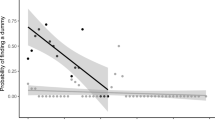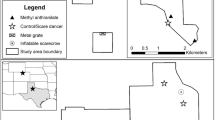Abstract
Birds feeding on landfill sites cause problems in terms of nuisance to neighbors, flight safety, a threat to public health, and affecting the day to day site operation. A number of control measures exist to deter problem species; however, research into their effectiveness across sites and for multiple species has been limited. We use a modeling approach in order to assess the effectiveness of nine techniques — pyrotechnics, hand-held distress calls, static distress calls, blank ammunition, a combination of blank and lethal use of ammunition, the use of falcons, the use of hawks, wailers and helium-filled bird-scaring kites — at deterring three commonly recorded species — the Black-headed Gull (Larus ridibundus), the Herring Gull (Larus argentatus) and the Lesser Black-backed Gull (Larus fuscus) — from six landfill sites across the United Kingdom. The use of distress calls, falconry, and combinations of lethal and nonlethal use of ammunition were the most effective techniques for initially deterring birds from these sites. However, when habituation is considered, there is a clear difference between techniques such as falconry, which have a lethal aspect and may act to reinforce the deterrence, and the use of techniques such as distress calls, which do not. However there are problems related to legislation and public perception when lethal techniques are used.







Similar content being viewed by others
References
Allan J (2002) The Costs Of Birdstrikes And Birdstrike Prevention. In: Clarke L (ed) Human Conflicts With Wildlife: Economic Considerations. US Department of Agriculture, Fort Collins, USA pp. 147–153
Andelt WF, Hopper. SN (1996) Effectiveness of alarm-distress calls for frightening herons from a fish-rearing facility. Progressive-Fish Culturist 58:258–262
Barr JF, Lurz PWW, Shirley MDF, Rushton SP (2002) Evaluation of Immunocontraception as a Publicly Acceptable Form of Vertebrate Pest Species Control: The Introduced Grey Squirrel in Britain as an Example. Environmental Management 30:342–351
Baxter A (2000) Use of distress calls to deter birds from landfill sites near airports. International bird strike committee. Amsterdam 17–21:402–408
Baxter A, St. James K, Thompson R, Laycock H (2003) Predicting the birdstrike hazard from gulls at landfill sites. International Bird Strike Committee. Warsaw 5–9
Baxter AT, Allan JR (2006) Use of Raptors to Reduce Scavenging Bird Numbers at Landfill sites. Wildlife Society Bulletin 34:1162–1168
Belant JL, Ickes SI (1997) Mylar Flags as Gull Deterrents. 13th Great Plains Wildlife Damage Control Workshop Proceedings. Lied Conference Centre, Nebraska City, Nebraska, April 16–19 1997. Kansas State University Agricultural Experiment Station and Cooperative Extension Service. Kansas pp 73–81
Blokpoel H (1976) Bird Hazards to Aircraft. Clarke, Irwin & Co. Ltd., Canada
Blokpoel H (1977) The use of falcons to disperse nuisance birds at Canadian airports: an update. Proc.World Conf. on Bird Hazards to Aircraft 3:179–187
Bomford O’Brien (1990) Sonic deterrents in animal damage control – a review of device tests and effectiveness. Wildlfie Society Bulletin 18:411–422
Bosch M, Oro D, Cantos FJ, Zabala M (2000) Short-term effects of culling on the ecology and population dynamics of the yellow-legged gull. Journal Of Applied Ecology 37:369–395
BPCA (British Pest Control Association) (2006) BPCA membership doubles over the last ten years. Professional Pest Controller 36:10–11
Brown KM, Erwin RM, Richmond ME, Buckley PA, Tancredi TJ, Avrin D (2001) Managing Birds and Controlling Aircraft in the Kennedy Airport-Jamaica Bay Wildlife Refuge Complex: The Need for Hard Data and Soft Options. Environmental Management 28:207–224
Burger J (2001) Landfills, nocturnal foraging, and risk to aircraft. Journal of Toxicology and Environmental Health Part A.64:273–290
Burnham KP, Anderson DR (2002) Model selection and Multi-model Inference A Practical Information-theoretic Approach. Springer-Verlag, New York
Cramp S, Simmons KEL (eds) (1980) The Birds of the Western Palearctic Volume II: Hawks to Bustards. Oxford University Press, Oxford, UK
Delwiche MJ, Houk AP, Gorenzel WP, Salmon TP (2005) Electronic broadcast call unit for bird control in orchards. Applied Engineering in Agriculture 21:721–727
Dolbeer RA, Belant JL, Sillings JL (1993) Shooting gulls reduces strikes with aircraft at John F. Kennedy International Airport. Wildlife Society Bulletin 21:442–450
Ellis TM, Bousfield RB, Bissett LA, Dyrting KC, Luk GSM, Tsim ST, Sturm-Ramirez K, Webster RG, Guan Y, Peiris JSM (2004) Investigation of outbreaks of highly pathogenic H5N1 avian influenza in waterfowl and wild birds in Hong Kong in late 2002. Avian Pathology 33:492–505
Erickson WA, Marsh RE, Salmon TP (1990) A review of falconry as a bird-hazing technique Proceedings of the Fourteenth Vertebrate Pest Conference 1990. University of Nebraska, Lincoln pp. 314–316
Fernández-Juricic E, Blumstein DT, Abrica G, Manriquez L, Bandy Adams L, Adams R, Daneshrad M, Rodriguez-Prieto I (2006) Relationships of anti-predator escape and post-escape responses with body mass and morphology: a comparative avian study. Evolutionary ecology research 8:731–752
Ferns PN, Mudge GP (2000) Abundance, diet and Salmonella contamination of gulls feeding at sewage outfalls. Water Research 34:2653–2660
Finney SK, Harris MP, Keller LF, Elston DA, Monaghan P, Wanless S (2003) Reducing the density of breeding gulls influences the pattern of recruitment of immature Atlantic puffins Fratercula arctica to a breeding colony. Journal of Applied Ecology 40:545–552
Gilsdorf JM, Hygnstrom SE, VerCauteren KC (2002) Use of frightening devices in wildlife damage management. Integrated Pest Management Reviews 7:29–45
Gorenzel WP, Blackwell BF, Simmons GD, Salmon TP, Dolbeer RA (2002) Evaluation of lasers to disperse American crows, Corvus brachyrynchos, from urban night roosts. International Journal Of Pest Management 48:327–331
Gosler AG, Kenward RE, Horton N (1995) The effect of gull roost deterrence on roost occupancy, daily gull movements and wintering wildfowl. Bird Study 42:144-157
Grinnell J (1932) Current discussion: The “control” of birds as causing popular disregard for the values of birdlife. Condor. 34:54–55
Guillemette M, Brousseau P (2001) Does culling predatory gulls enhance the productivity of breeding common terns? Journal Of Applied Ecology 38:1–8
Hollmen T, Franson JC, Docherty DE, Kilpi M, Hario M, Creekmore LH, Peterson MR (2000) Infectious bursal disease antibodies in Elder ducks and Herring Gulls. Condor 102:688–691
Ihake R, Gentleman R (1996) R: A language for data analysis and graphics. Journal Of Computational and Graphical Statistics 5:229–314
Littauer GA, Glahn JF, Reinhold DS, Brunson MW (1997) Control of Bird Predation at Aquaculture Facilities: Strategies and Cost Estimates. Southern Regional Aquaculture Centre Publication No. 402
McAtee WL (1933) The Meaning of bird control. The Wilson Bulletin 45:3–9
Monaghan P, Shedden CB, Ensor K, Fricker CR, Girdwood RWA (1985) Salmonella carriage by herring-gulls in the Clyde area of Scotland in relation to their feeding ecology. Journal Of Applied Ecology 22:669–680
National Farmers Union (2005) Code of Practice: Bird scarers. Available from http://www.malvern.whub.org.uk/home/mhc-env-birdscarers-cop.pdf (Accessed 01/06/2007)
Olijnyk CG, Brown KM (1999) Results of a seven year effort to reduce nesting by Herring and Great Black-backed Gulls. Waterbirds 22:285–289
Palmgren H, Aspan A, Broman T, Bengtsson K, Blomquist L, Bergstrom S, Sellin M, Wollin R, Olsen B (2006) Salmonella in Black-headed gulls (Larus ridibundus); prevalence, genotypes and influence on Salmonella epidemiology. Epidemiological Infection 134:635–644
Pinheiro JC, Bates DM (2000) Mixed-effects models in S and S-PLUS. First edition. Springer Verlag New York, LLC, New York, USA
R Development Core Team (2005) R: A language and environment for statistical computing. R Foundation for Statistical Computing, Vienna, Austria
Ronconi RA, St. Clair CC (2006) Efficacy of a radar-activated on-demand system for deterring waterfowl from oil sands tailings ponds. Journal of Applied Ecology. 43:111–119
Ronconi RA,St. Clair CC, O’Hara PD, Burger AE (2004) Waterbird deterrence at oil spills and other hazardous sites: potential applications of a radar activated on demand deterrence system. Marine Ornithology 32:25–33
Stevens GR, Rogue J, Weber R, Clark L (2000) Evaluation of a radar activated, demand-performance bird hazing system. International biodeterioration and biodegradation 45:129–137
Vogt PF (1997) Control of Nuisance Birds by Fogging with ReJeX-iT® TP-40. 13th Great Plains Wildlife Damage Control Workshop Proceedings. pp 63–67. Lied Conference Centre, Nebraska City, Nebraska, April 16–19 1997. Kansas State University Agricultural Experiment Station and Cooperative Extension Service. Kansas
Wallace JS, Cheasty T, Jones K (1997) Isolation of Vero cytotoxin-producing Escherichia coli O157 from wild birds. Journal Of Applied Microbiology 82:399–404
White PCL, Whiting SJ (2000) Public attitudes towards badger culling to control bovine tuberculosis in cattle. Veterinary Record 147:179–184
Acknowledgments
This work was funded by the UK Department for the Environment, Food and Rural Affairs (DEFRA). Fieldwork was carried out by the Central Science Laboratory (CSL). Aonghais Cook was supported by a joint CSL/Newcastle University studentship. We also thank three anonymous reviewers for their comments.
Author information
Authors and Affiliations
Corresponding author
Rights and permissions
About this article
Cite this article
Cook, A., Rushton, S., Allan, J. et al. An Evaluation of Techniques to Control Problem Bird Species on Landfill Sites. Environmental Management 41, 834–843 (2008). https://doi.org/10.1007/s00267-008-9077-7
Published:
Issue Date:
DOI: https://doi.org/10.1007/s00267-008-9077-7




